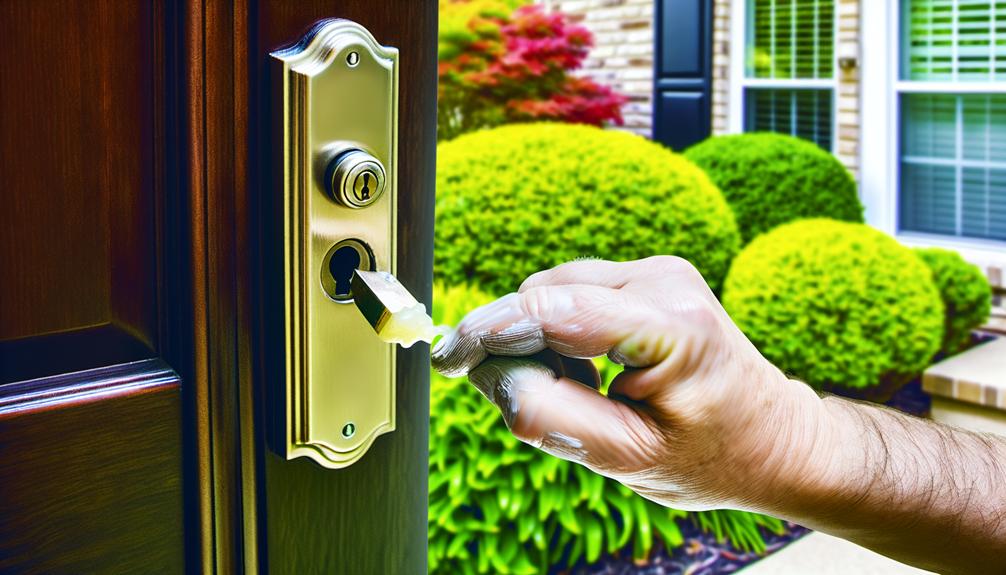As NJ homeowners, we need to prioritize regular lock maintenance to guarantee our homes stay secure. Clean locks to remove dust and debris, and use graphite powder or silicone-based sprays for lubrication. Regularly inspect for signs of wear and rust, and make sure door frames are properly aligned. Tighten screws and replace worn keys to maintain lock functionality. Protect locks from weather with coatings and covers, and avoid using excessive force when turning keys. Upgrading to high-security deadbolts or smart locks can enhance security. To explore more in-depth techniques and tips, let’s continue.
Key Takeaways
- Regularly clean and lubricate locks to ensure smooth operation and longevity.
- Inspect locks for wear, rust, and proper alignment to maintain security.
- Replace worn keys and test lock functionality frequently to prevent issues.
- Tighten and check screws on locks and hinges to ensure secure door closure.
- Apply weatherproof coatings and use lock covers to protect from harsh weather conditions.
Regular Cleaning

To maintain our locks in the best condition, we should regularly clean them to remove dust, grime, and other debris that could impair their function. A routine deep cleaning guarantees our locks not only operate smoothly but also last longer, enhancing the security of our homes. We’ll start by using a soft, lint-free cloth to wipe down the exterior of the lock, focusing on the keyway and any exposed parts.
For a more thorough deep cleaning, we need to disassemble the lock according to the manufacturer’s instructions. This step is essential for preventative maintenance, as it allows us to access and clean the internal components, removing any hidden debris that could cause wear or malfunction over time. We should use a gentle brush and a mild cleaning solution to scrub away built-up grime.
After cleaning, we need to reassemble the lock carefully, ensuring each part is correctly aligned. This meticulous approach prevents future issues and keeps our locks functioning at their best.
Lubricate the Mechanism
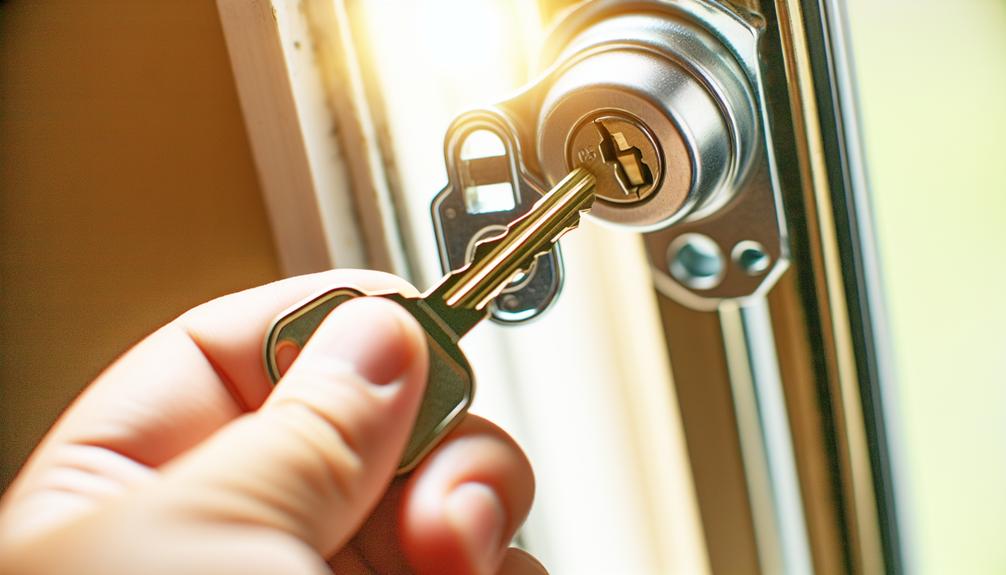
An essential step in maintaining our locks is to lubricate the mechanism regularly to guarantee smooth operation and longevity. We need to start by identifying the right lubrication techniques.
Dry lubricants, such as graphite powder, are highly effective because they don’t attract dust and dirt. Apply a small amount directly into the keyhole and then insert the key, turning it gently to distribute the lubricant within the mechanism.
For those who prefer liquid lubricants, silicone-based sprays are recommended. These sprays penetrate the internal components of the lock without causing buildup. To use, spray a modest amount into the keyhole and any moving parts like the latch or bolt, then operate the lock several times to make sure even distribution.
Preventing lock malfunctions through maintenance is vital. Regular lubrication minimizes wear and tear on internal components, reducing the risk of jamming or complete lock failure. When selecting products, avoid petroleum-based options as they can gum up the mechanism over time.
Always keep a dedicated lock lubricant on hand and incorporate this step into our seasonal home maintenance routine.
Inspect for Damage
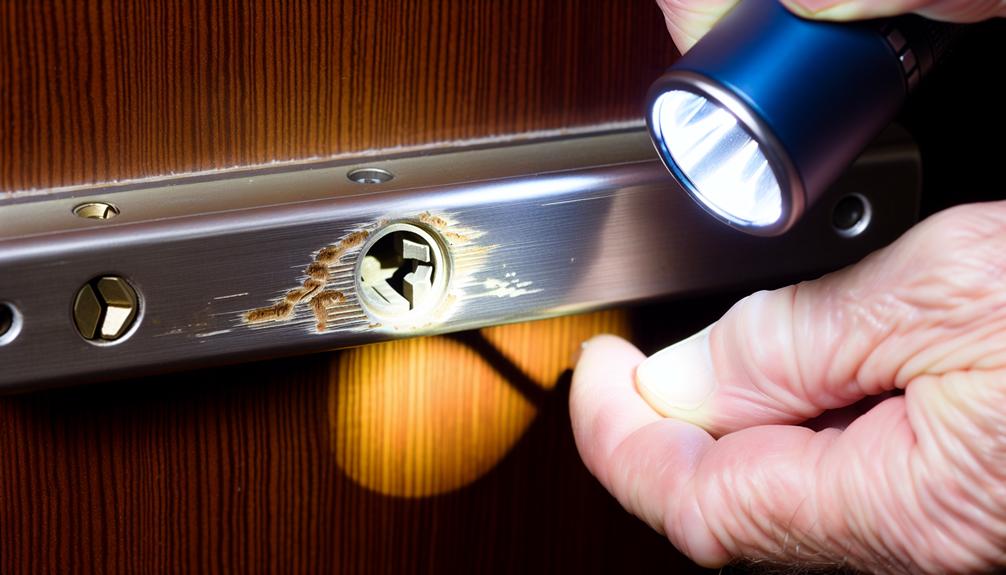
Let’s regularly check our locks for wear and rust signs to make sure they’re functioning at their best.
Worn or rusted components can compromise our home’s security, making it easier for intruders to gain access.
Check for Wear
Regularly checking your locks for signs of wear and damage can prevent potential security breaches and safeguard your home’s safety. To confirm our locks remain in top condition, we should create a structured maintenance checklist. This list should include inspecting each lock for any signs of physical wear, such as loose components, difficulty turning the key, or visible scratches. These issues, if left unresolved, can compromise our home’s security.
In addition to the physical inspection, we should focus on rust prevention. Rust can weaken lock mechanisms, making them more susceptible to tampering or failure. Regularly applying a lubricant designed for locks can help prevent rust formation and ensure smooth operation.
For those of us seeking advanced security solutions, considering keyless entry options might be beneficial. These systems reduce the mechanical wear associated with traditional keys and can offer enhanced security features, such as biometric access or remote control.
Identify Rust Signs
Regularly checking our locks for rust signs is important to maintaining their integrity and ensuring our home’s security. Rust can weaken the metal, making it easier for intruders to tamper with or break the lock.
Let’s explore practical maintenance techniques for rust prevention.
First, we should inspect our locks at least once a month. Look for any discoloration, which often appears as reddish or brownish spots. If we notice any, it’s vital to address them immediately. Use a brush to clean off surface rust and apply a rust-inhibiting lubricant to protect the metal.
For more advanced rust signs, such as pitting or flaking, we might need to sand the affected areas gently. After sanding, applying a rust converter can help neutralize any remaining corrosion. This step is important for long-term rust prevention, ensuring our locks remain functional and secure.
Additionally, consider the lock’s environment. High humidity and exposure to rain can accelerate rust formation. Using weather-resistant locks or adding protective covers can greatly reduce these risks.
Check Door Alignment
Let’s make certain our doors are properly aligned to maintain lock security.
We should start by inspecting the frame positioning to see if the door fits snugly within the frame.
If we notice any misalignment, correcting hinge issues will help guarantee the door closes and locks securely.
Inspect Frame Positioning
Maintaining that your door aligns correctly with its frame is crucial for preserving the security and functionality of your locks. When we discuss frame alignment, we’re addressing how well the door fits within its frame. Misalignment can compromise door security, making it easier for potential intruders to force entry.
Let’s go through how we can inspect and correct these issues.
First, let’s examine the gap between the door and the frame. It should be consistent along the top and sides. If we notice any irregularities, it could indicate that the frame isn’t aligned properly. We can use a level to check the vertical and horizontal alignment of both the door and the frame.
Next, we should focus on reinforcing frames. Weak or damaged frames are a common target for break-ins. By installing reinforcement plates or using longer screws to secure the frame to the wall studs, we can greatly enhance the door’s resilience. This not only helps in preventing break-ins but also ensures that our locks function at their best.
Lastly, let’s make sure that the strike plate is correctly aligned with the latch. This small step can make a significant difference in both security and ease of use.
Correct Hinge Issues
Identifying and correcting hinge issues is critical for maintaining proper door alignment and ensuring your locks function effectively. First, we need to examine the hinges for any signs of wear or damage. Common issues include loose screws, warped hinges, or misalignment. If the screws are loose, tighten them using a screwdriver. For warped hinges, replacing them is often the best solution.
Next, let’s use troubleshooting techniques to check the door alignment. Close the door and observe if it fits snugly within the frame. If there’s a gap or if the door drags on the floor, we may need to adjust the hinges. To do this, we can slightly loosen the screws and reposition the hinge until the door is properly aligned.
For DIY hinge repairs, it’s important to have the right tools on hand, including a screwdriver, a level, and replacement screws or hinges if necessary.
Regular hinge maintenance can prevent many of these common issues and keep our doors operating smoothly. Ensuring our doors are correctly aligned not only improves functionality but also enhances the security of our home by allowing locks to engage properly.
Let’s take control and make these adjustments to maintain our home’s security.
Tighten Loose Screws
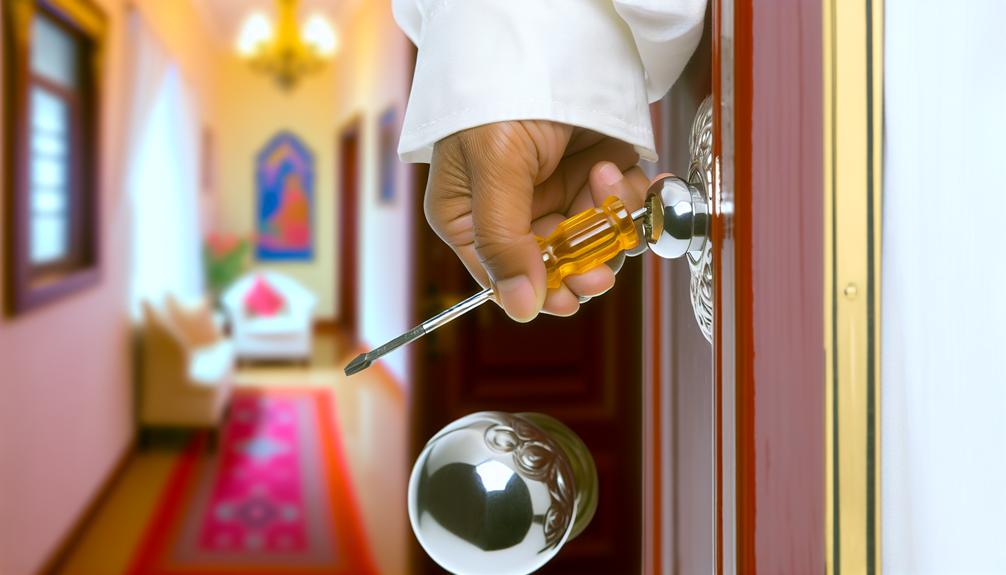
We should regularly check and tighten any loose screws in our door locks to guarantee maximum security and functionality. Loose screws can compromise door security, making it easier for intruders to manipulate the lock or force entry. Screw maintenance is essential for the longevity and reliability of our locks.
When we notice any wobbling or misalignment, it’s a sign that the screws need attention. We should use a screwdriver to tighten each screw firmly, guaranteeing they are secure but not overly tightened, which could strip the threads. Regular screw maintenance not only enhances door security but also prevents potential lock malfunctions.
Here’s a quick reference table for screw maintenance:
| Inspection Point | Action Needed |
|---|---|
| Door Lock Screws | Tighten uniformly |
| Strike Plate Screws | Ensure full contact |
| Hinge Screws | Check and secure |
Replace Worn Keys
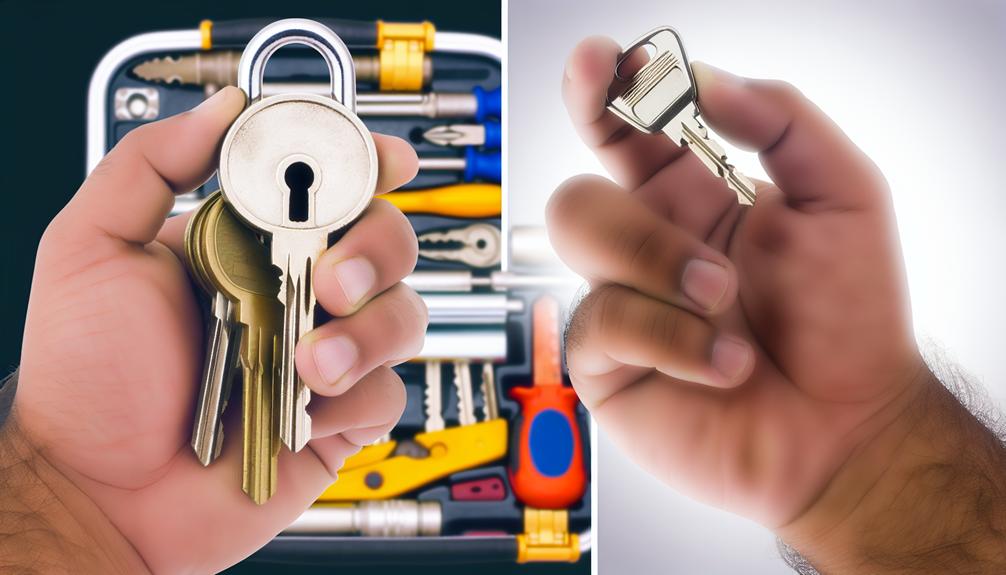
When we notice our keys are worn, it’s important to replace them promptly to maintain security.
Worn keys can damage locks and make our homes more vulnerable to break-ins.
Let’s explore the signs of key wear and how to choose the right replacements.
Signs of Key Wear
Worn keys can be a security risk, so it’s essential to recognize the signs of key wear to maintain your home’s safety. By understanding these signs, we can take proactive steps to guarantee our locks function smoothly and remain secure.
- Visible damage: Look for bends, cracks, or worn-down teeth on the key. These signs indicate that the key may not engage the lock correctly, increasing the risk of malfunction and breakage.
- Difficulty turning: If the key requires excessive force to turn in the lock, it’s a clear sign that it’s worn. This can lead to further wear on both the key and lock mechanism, potentially causing a lockout situation.
- Inconsistent operation: If the key works sometimes but not always, it’s a sign the key’s wear is progressing. This inconsistency can be a precursor to total key failure.
To prevent key breakage and malfunction, we should regularly inspect our keys and address any signs of wear promptly. Key maintenance is crucial, and exploring replacement options when wear is detected can save us from future inconvenience and security risks.
Choosing Replacement Keys
Choosing high-quality replacement keys is essential for ensuring the longevity and security of our locks. When it comes to key duplication, we need to be meticulous. Poorly duplicated keys can wear down locks faster and increase security concerns. To avoid these issues, we should always opt for professional locksmiths who use precision-cutting machines.
Replacing worn keys also presents us with an opportunity to contemplate whether we should switch from traditional keys to electronic ones. Electronic keys offer enhanced security features, such as unique codes and encryption, which are far more challenging to duplicate. While electronic keys may require a higher initial investment, they can provide greater control over who has access to our property.
Traditional keys, on the other hand, are simpler and more cost-effective but come with their own set of security concerns. They’re easier to duplicate and can wear out more quickly. If we choose to stick with traditional keys, selecting durable materials like brass or nickel silver can extend their lifespan.
Test Lock Operation
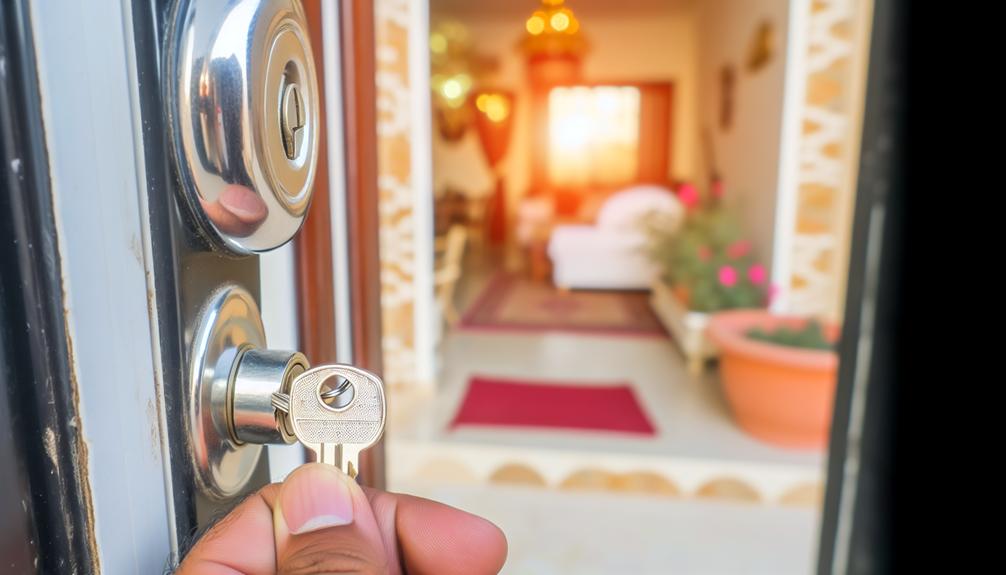
Ensuring the smooth operation of your security mechanisms is essential for maintaining the safety of your home. Regular maintenance of these mechanisms is vital for identifying potential issues before they become significant challenges. By understanding the mechanisms of locks and their functionality, we can pinpoint and resolve issues efficiently.
First, let’s test our security mechanism’s operation step by step:
- Insert and Turn: Insert the key and turn it to verify it moves smoothly without any obstacles. If it’s sticking, we might need to apply lubrication to the internal components using a graphite-based lubricant.
- Latch Operation: Make sure that the latch fully extends and retracts when the key is turned. If the latch doesn’t move freely, check for any blockages or misalignment with the strike plate.
- Lock and Open: From both sides of the door, verify that the lock engages and disengages correctly. If there’s a delay or it feels loose, we may need to adjust or tighten the screws holding the lock in place.
These troubleshooting techniques help identify problems early.
Understanding the intricacies of our security mechanisms empowers us to maintain them effectively, ensuring the best possible safety.
Regularly testing our security mechanisms not only enhances their longevity but also provides peace of mind knowing our home remains secure.
Upgrade When Necessary
When our locks exhibit signs of wear or outdated technology, upgrading is crucial to maintain peak home security. Regular lock maintenance assists us in identifying when a lock is no longer performing at its best. A lock that sticks, has difficulty turning, or shows visible damage is a clear indicator that it’s time for an upgrade.
We need to contemplate security upgrades that provide us with the best protection. High-security deadbolts, smart locks, and keyless entry systems offer superior security features that traditional locks lack. These modern solutions often come with enhanced resistance to picking, bumping, and other forced entry methods. By upgrading, we guarantee our homes are protected by the latest advancements in lock technology.
Moreover, we should evaluate our current locks’ compatibility with our overall security system. If our locks don’t integrate well with alarm systems or surveillance cameras, it’s another indication that an upgrade is necessary. We must prioritize locks that offer seamless connectivity and improved control.
Protect From Weather
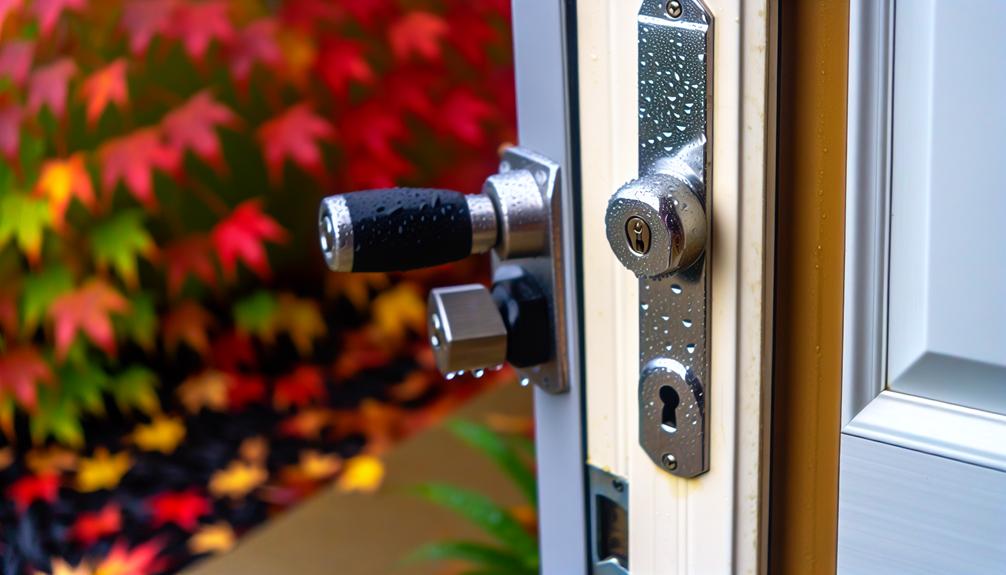
To prolong the lifespan of our locks, we must shield them from severe weather conditions that can result in rust, corrosion, and malfunctions. Implementing weatherproofing methods and conducting seasonal maintenance are essential steps.
Here’s a focused approach:
- Apply Weatherproof Coatings: Coatings like silicone or Teflon spray can create a protective barrier against moisture and dirt. Regular application guarantees that our locks remain functional and free from rust.
- Utilize Lock Covers: Investing in lock covers or shields can offer additional protection. These covers prevent direct exposure to rain, snow, and ice, thereby assisting in damage prevention and extending the lock’s life.
- Seasonal Inspection and Lubrication: During seasonal maintenance, we should examine our locks for signs of wear and tear. Lubricating them with a weather-resistant lubricant helps maintain smooth operation even in adverse conditions.
Adopting these measures allows us to maintain control over the security of our homes. By being proactive, we can guarantee that our locks remain durable and reliable.
Avoid Extreme Force

We should always handle our locks with care to prevent unnecessary strain that could result in damage or malfunction. When we use excessive force on a lock, we’re not just risking immediate breakage; we could be causing long-term issues that undermine the lock’s integrity. Proper maintenance begins with gentle handling.
When turning a key, we should do so smoothly and avoid jerking or twisting it too forcefully. If a lock feels stiff or unresponsive, it’s better to lubricate it with a suitable lock lubricant rather than forcing it. Lubrication reduces friction and helps in avoiding damage to the internal components.
In addition, let’s make sure that we’re inserting the key correctly. Misalignment can cause key breakage or harm to the lock cylinder. We should periodically check the lock alignment with the door frame, making adjustments as necessary to maintain smooth operation.
Moreover, when a lock isn’t working correctly, it’s important to address the issue promptly. Ignoring minor problems can lead to major failures and compromise our home security. By practicing proper maintenance and avoiding excessive force, we can extend the lifespan of our locks and guarantee they function reliably.
Use Quality Products
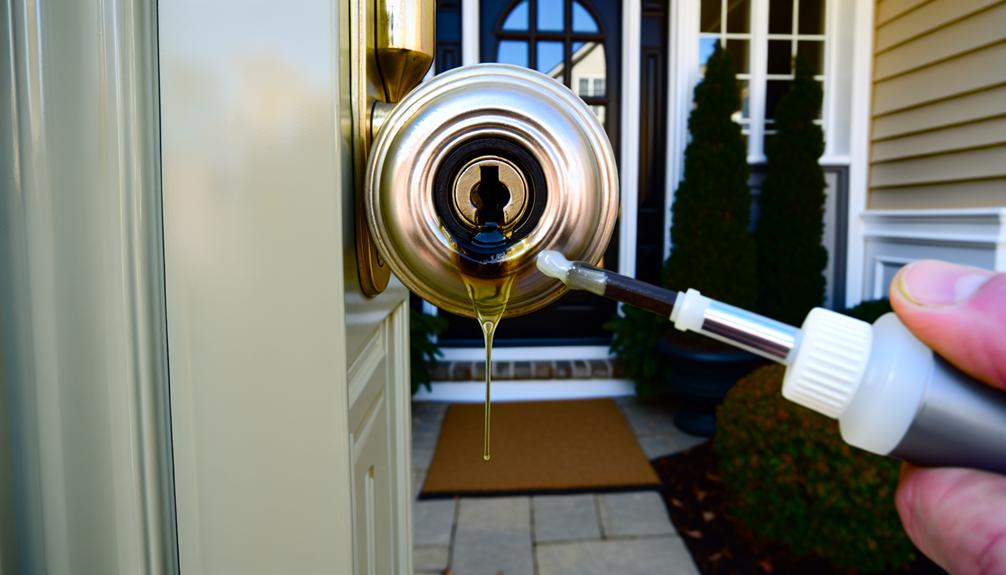
Handling our locks with care is important, but using quality products is equally essential for guaranteeing their longevity and reliability. We must select products that are compatible with our specific lock types to avoid any long-term effects that could compromise security or functionality. Using inferior products might save us money upfront, but they could lead to costly repairs or replacements down the line.
To make informed decisions, we should consider the following:
- Product Compatibility: Guarantee that the products we choose, such as lubricants and cleaning agents, are designed for our lock types. Incorrect products can cause wear and tear, leading to decreased efficiency or total lock failure.
- Brand Reputation: Reliable brands tend to produce higher-quality products. We should opt for well-known brands with a history of excellence in the lock industry. Their commitment to quality often translates into better and longer-lasting performance.
- User Reviews: Before purchasing, let’s check user reviews and ratings. Real-world feedback from other homeowners can provide valuable insights into the product’s effectiveness and any potential issues that aren’t immediately apparent.
Seek Professional Help
Consistently seeking expert assistance secures our locks to maintain peak performance and security standards. While DIY solutions can be tempting for cost-saving reasons, they often lead to common mistakes such as improper installation or using incompatible parts. These errors compromise both the lock’s functionality and our home’s security.
We need to recognize when to seek help. If our locks are showing signs of wear, or malfunctioning, or if we’ve experienced a break-in attempt, it’s important to contact a professional locksmith. They possess the technical expertise to diagnose and repair issues that aren’t apparent to the untrained eye.
Additionally, professional locksmiths can provide insights into the latest security technologies, making sure our homes are equipped with state-of-the-art protection.
Cost considerations are essential, but we must weigh the expense of professional services against potential risks. A poorly executed DIY repair can end up costing more in the long run due to additional damage or security breaches. By investing in expert assistance, we guarantee the integrity of our lock systems and, ultimately, the safety of our household.
Prioritizing expert intervention over DIY solutions is a prudent approach to maintaining robust home security.
Frequently Asked Questions
How Can I Prevent My Locks From Freezing in Cold Weather?
To prevent our locks from freezing, we should focus on winter lock care by applying de-icing techniques and using weatherproofing locks. Additionally, insulation options like rubber covers can be effective in maintaining security during cold weather.
Are There Any Eco-Friendly Lock Maintenance Products Available?
Why not choose sustainable solutions for lock maintenance? We’ve found green alternatives like natural lubricants and eco-friendly options that work just as well. These natural products guarantee security and control without harming the environment.
How Often Should I Update My Lock System for Optimal Security?
We should update our lock system every 3-5 years for best maintenance. Regular security updates guarantee our home maintains high security levels. Staying proactive with our lock system keeps us in control and safeguards our property.
What Are the Best Practices for Maintaining Smart Locks?
While traditional locks need occasional lubrication, smart lock troubleshooting focuses on software updates and battery checks. For keyless entry maintenance, we should make sure firmware is current and test backup power options to maintain security and control.
Can I Use DIY Methods to Fix Minor Lock Issues?
Yes, we can use DIY methods for minor lock issues. Regular lock lubrication prevents sticking, and key duplication guarantees we have spares. These simple steps enhance security and give us more control over our home’s access.
Conclusion
By following these steps, we’re not just maintaining our locks; we’re fortifying our homes. Think of it as armor for our castle. Regular maintenance is like a watchful guardian, ensuring our security stands the test of time.
Let’s invest in quality products and not shy away from professional help when needed. With a little care and attention, we can keep intruders at bay and our peace of mind intact. Our homes deserve nothing less.

